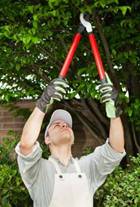By: Timothy Cline, CIRMS
By definition, a handyperson is like a human Swiss Army knife—a convenient way to efficiently accomplish a variety of tasks. Always cheaper than hiring a contractor, a handyperson represents a budget-saving alternative; helping to keep maintenance costs for the community association lower and, at least at first blush, being a task-accomplishing hero to cost-conscious board members and the owners they represent. As enticing as it is to go to Craigslist or Angie’s List to hire a handyperson, is it a fiscally responsible business decision for a board of directors? Or does hiring a contractor simply create a heightened exposure for their community?
There are many eye-opening considerations:
Handypersons are typically unlicensed.
 In California, there is no “handyperson” classification available through the State’s Contractors State Licensing Board (CSLB). The absence of a license is problematic for both the individual and the association. If the total value of the construction work being performed meets or exceeds $500 (for both labor and materials), a license is required. Penalties for an individual contracting without a license can range from a warning letter to jail time, depending on the severity of the offense. For the condominium association, inadvertently hiring an unlicensed contractor (an individual performing a task for which a license is required) means that there are fewer remedies if things go wrong. The State CSLB will not step in and resolve any dispute should the association be dissatisfied. Furthermore, should litigation ensue, a contractor’s license helps to establish an “independent contractor” relationship which may help insulate a board of directors for the individual’s actions.
In California, there is no “handyperson” classification available through the State’s Contractors State Licensing Board (CSLB). The absence of a license is problematic for both the individual and the association. If the total value of the construction work being performed meets or exceeds $500 (for both labor and materials), a license is required. Penalties for an individual contracting without a license can range from a warning letter to jail time, depending on the severity of the offense. For the condominium association, inadvertently hiring an unlicensed contractor (an individual performing a task for which a license is required) means that there are fewer remedies if things go wrong. The State CSLB will not step in and resolve any dispute should the association be dissatisfied. Furthermore, should litigation ensue, a contractor’s license helps to establish an “independent contractor” relationship which may help insulate a board of directors for the individual’s actions.
Many handypersons have no liability coverage.
If there is any property damage or bodily injury that results from a handyperson’s activities, it’s unlikely the handyperson would have liability coverage to address the resulting claim/lawsuit. By comparison, commercial general liability coverage, which is typically maintained by licensed contractors, provides two distinct benefits: (1) an association can request to be named as an “Additional Insured” on the contractor’s liability policy and, thus, potentially be provided with defense and indemnity should the HOA be named in a lawsuit; and (2) if there is a claim that is tendered to the association’s property or liability insurance coverage, the factthe contractor has liability coverage may provide a recovery opportunity (an option to subrogate against the contractor’s policy) softening or eliminating the impact on the association’s loss history.
Handypersons typically do not maintain any workers’ compensation coverage.
There have been a number of cases in California where a person who claims to be an independent contractor gets injured, then turns around and claims to be an employee of the association to collect workers’ compensation benefits.
 In some circumstances, the erosion of the independent contractor relationship is codified in case law. For example, if the association hires an individual to perform a task for which a license is required, that individual will immediately be deemed to be the employee of the association for workers’ compensation benefits (State Compensation Ins. Fund v. Workers’ Comp. Appeals Board (1985) 40 Cal.3d 5, 12-16). This provision of the Labor Code makes an unlicensed contractor who is performing work for which a license is required an employee of the hirer, for the purpose of workers’ compensation. How easily could such an issue arise? In a former newsletter, we discussed that the California Business and Professional Code requires a contractor’s license to trim a tree measuring 15 feet or more. (Bus. & Prof. Code, § 7026.1, subd.(c)). If your handyperson is on a ladder trimming even the lowest branch on a fifteen-foot tree and is injured, he could be deemed the association’s employee and entitled to full workers’ compensation benefits.
In some circumstances, the erosion of the independent contractor relationship is codified in case law. For example, if the association hires an individual to perform a task for which a license is required, that individual will immediately be deemed to be the employee of the association for workers’ compensation benefits (State Compensation Ins. Fund v. Workers’ Comp. Appeals Board (1985) 40 Cal.3d 5, 12-16). This provision of the Labor Code makes an unlicensed contractor who is performing work for which a license is required an employee of the hirer, for the purpose of workers’ compensation. How easily could such an issue arise? In a former newsletter, we discussed that the California Business and Professional Code requires a contractor’s license to trim a tree measuring 15 feet or more. (Bus. & Prof. Code, § 7026.1, subd.(c)). If your handyperson is on a ladder trimming even the lowest branch on a fifteen-foot tree and is injured, he could be deemed the association’s employee and entitled to full workers’ compensation benefits.
California’s State Compensation Insurance Fund (State Fund) does offer an alternative for the sole proprietor: the opportunity for the handyperson to purchase their own coverage. Unfortunately, few handypersons avail themselves of this opportunity holding firm to the belief that because they have no employees, they are not required to maintain protection. No one would judge them for trying to keep their expenses down, but failing to maintain their own coverage and their lack of a valid contractor’s license likely means that the exposure for any injury sustained by a handyperson on the premises will commute to the association.
There are 43 different construction trade licenses recognized in California. That’s potentially 43 different ways your handyperson, and by extension, your association could get in hot water. Risk transfer is a way to protect the association and the association’s claims history from the calamities caused by inexperienced and under-qualified workers. The cost/benefit analysis for using a handyperson may be favorable, but only in the short term—until there’s a claim. Using licensed and insured contractors is an important first step for the board to properly manage risk.

